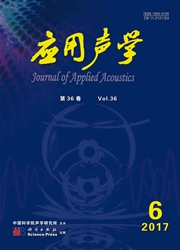

 中文摘要:
中文摘要:
缓变信道下基于LMS算法的信道估计算法具有较好的跟踪性能,但对快变信道,LMS算法跟踪性能下降。SOLMS算法具有比LMS算法更好的跟踪性能,尤其是在快变的信道下。但由于SOLMS算法在收敛阶段的振荡性,这时收敛速度较LMS算法慢。本文提出一种收敛模式下用LMS算法获得信道的参数,收敛后则切换成SOLMS算法跟踪信道的变化的信道估计方法。新方法结合了LMS算法收敛快和SOLMS算法跟踪性能好的优点。对时变多径水声信道估计的计算机仿真实验证明了该方法的有效性。
 英文摘要:
英文摘要:
Channel estimation based on LMS algorithm can work well under slowly time-varying channel. In tracking fast varying channel, however it can not provide satisfactory performance. SOLMS algorithm outperforms LMS algorithm in channel tracking especially in the fast changing channel, and yet, due to the oscillation nature of SOLMS algorithm, SOLMS algorithm converges more slowly than LMS algorithm. This paper presents a novel method of channel estimation which initially uses LMS algorithm to acquire channel parameters in the convergence mode and then converts to SOLMS algorithm for channel tracking after convergence. This new method combines the merits of the fast convergence rate of the LMS algorithm and the better tracking performance of SOLMS algorithm. The effectiveness of this new method is verified via the computer simulation of time-varying underwater acoustic multipath channel estimation.
 同期刊论文项目
同期刊论文项目
 同项目期刊论文
同项目期刊论文
 期刊信息
期刊信息
